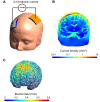Transcranial electric stimulation seen from within the brain
- PMID: 28350293
- PMCID: PMC5370182
- DOI: 10.7554/eLife.25812
Transcranial electric stimulation seen from within the brain
Abstract
Computer models can make transcranial electric stimulation a better tool for research and therapy.
Keywords: computational current-flow model; human; intracranial recordings; neuroscience; transcranial electric stimulation.
Conflict of interest statement
AVP: An inventor on patents and patent applications and recipient of research and travel support as well as patent royalties from Rogue Research; research and travel support, consulting fees, as well as equipment loan from Tal Medical; patent application support from Magstim; and equipment loans from MagVenture, all related to technology for transcranial magnetic stimulation.
Figures

Comment on
-
Measurements and models of electric fields in the in vivo human brain during transcranial electric stimulation.Elife. 2017 Feb 7;6:e18834. doi: 10.7554/eLife.18834. Elife. 2017. PMID: 28169833 Free PMC article.
References
-
- Koessler L, Colnat-Coulbois S, Cecchin T, Hofmanis J, Dmochowski JP, Norcia AM, Maillard LG. In-vivo measurements of human brain tissue conductivity using focal electrical current injection through intracerebral multicontact electrodes. Human Brain Mapping. 2017;38:974–986. doi: 10.1002/hbm.23431. - DOI - PMC - PubMed
Publication types
MeSH terms
Grants and funding
LinkOut - more resources
Full Text Sources
Other Literature Sources

